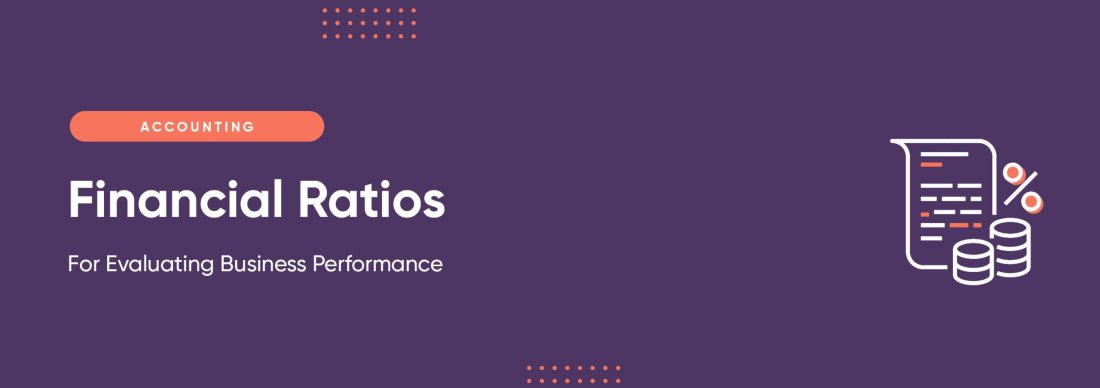Financial Ratios for Evaluating Business Performance
May 23, 2023 | 15 Min Read


Jump to Sections
Stay updated
with our Blogs
We will keep you updated about our latest blogs
Share This Blog
In today’s dynamically evolving business environment, financial statement analysis and evaluation of the financial performance of a company have become crucial for making well-informed business decisions.
The usage of financial reporting services and analysis of key financial ratios enables businesses to gain valuable insights into the multiple facets of the firm’s financial position.
What are Financial Ratios and Why Are They Important?
Financial ratios are numerical indicators used to assess and compare the relative financial health and performance of a business, with its past performance or industry benchmarks. They are derived from the company’s financial statements such as the income statement, balance sheet, and statement of cash flows.
Financial ratios are important for several reasons, some of which are discussed below:
Performance Evaluation: The financial analysis of a business via the use of ratios enables the management to compare the profitability, efficiency, liquidity, and leverage position of the firm over time. They can also compare their business performance relative to competitors to determine areas of improvement while assisting businesses in monitoring their progress toward the achievement of financial targets.
Planning and Decision Making: Financial ratios facilitate the management in making well-informed decisions about potential investment opportunities, and operational strategies, as well as budgeting and financing options. They can also help set realistic goals and strategies needed to achieve them.
Indicators of deteriorating financial health: Certain financial ratios act as an indicator of the deteriorating financial health of the business. For example, a declining liquidity ratio could indicate the inability of a firm to meet its short-term obligations, whereas an increasing leverage ratio could indicate excessive borrowings by the business.
Attracting Investors: Financial ratios can help lure investment or increase financing options for the business, as a strong set of ratios can indicate that the business is performing well.
Types of Financial Ratios
Profitability Ratios:
Profitability ratios focus on a company’s ability to generate profits from its operations. The key profitability ratios include:
- Gross Profit Margin: This ratio measures the percentage of revenue retained after deducting the cost of goods sold.
Gross Profit Margin ratio = Gross profit / Net sales
- Net Profit Margin: It determines the percentage of revenue remaining after all expenses, including taxes and interest, have been deducted.
Net Profit Margin = Net Income / Net Sales
- Return on Assets: This ratio assesses the profit-generating ability of the assets employed in the business.
Return on Assets = Net Income / Total Assets
- Return on Equity: It calculates how efficiently the business is using its equity to generate profits.
Return on Equity = Net Income / Shareholders Equity
By comparing the above ratios with past performance and industry averages, we can determine how well the financial performance of the business is.
Want to learn about the next steps for growing your business ?
Efficiency ratios
These ratios assess the operational effectiveness and resource utilization of a business. Below are the key efficiency ratios:
- Asset Turnover: This ratio measures a company’s ability to generate revenue from its assets. A higher value indicates more efficient utilization of assets.
Asset Turnover = Net Sales / Average Total Assets
- Inventory Turnover: This ratio measures how many times a company’s inventory is sold and replenished. This should be compared with competitors to determine whether the performance is on par with the industry standards. It is highly dependent on the product line of the business.
Inventory Turnover = Cost of Goods Sold / Average Inventory
- Trade Receivable Turnover: It indicates the number of times receivables are converted into cash during a specific period.
Receivables Turnover = Net Credit Sales / Average Receivables
It must be noted that allowing relaxed credit terms can negatively impact the cash flow of the business, while very strict credit terms to customers could result in a loss of business to competitors offering favorable payment terms.
Liquidity Ratios:
Liquidity ratios evaluate a company’s ability to meet short-term obligations. Key ratios include:
- Current Ratio: It measures the ability of the company to cover its current liabilities (those that must be repaid within 12 months).
Current Ratio = Current Assets / Current Liabilities
- Quick Ratio (also known as acid test ratio): This ratio provides a more stringent assessment of a company’s short-term liquidity by excluding inventory from current assets. Inventory may not be easily converted into cash; therefore, we take into account all assets that can be quickly converted into cash to pay off short-term obligations.
Quick Ratio = Current Assets (excluding inventory) / Current Liabilities
Ideally, liquidity ratios should be greater than 1, indicating that the current assets are sufficient to cover the current liabilities.
Financial Risk and Leverage Ratios:
Leverage ratios analyze a company’s capital structure and financial risk. The capital structure of a business comprises both equity (owner’s investment) and debt. Important ratios include:
- Debt-to-Equity Ratio: It compares the company’s total debt to its shareholder’s equity, assessing the proportion of financing provided by creditors versus shareholders. This ratio is closely monitored by investors and lenders as highly leveraged firms may pose significant financial risks to stakeholders.
Debt to Equity Ratio = Total Liabilities / Shareholders Equity
- Interest Coverage Ratio: This ratio assesses how easily a company can meet interest payments on its debt obligations. A high ratio suggests low financial risk.
Interest Cover = Operating Income / Interest Expense
Limitations of Financial Ratios
Financial ratios offer valuable insights into the financial health of a business. However, it is important to recognize their limitations as well.
Industry Variations: Ratios that are considered favorable in one industry may not be considered favorable in another. This is because every industry possesses unique operating mechanisms and financial characteristics. A high inventory turnover might not be seen in the airplane manufacturing business, but this is not a sign of the inability of the business to sell its inventory. Hence, ratios must be compared within the same sector to have useful insights.
Accounting Practices: Different accounting methods (such as different depreciation and inventory valuation methods chosen or differences in revenue recognition models) adopted by each business can affect the calculation and comparison of ratios between companies.
In some cases, companies may window-dress financial statements to present a more favorable picture, undermining the reliability of the financial ratios calculated.
Limited Scope: Financial ratios may not consider external factors that can impact the company’s performance such as changes in regulations, economic conditions, or consumer behavior. It also does not consider qualitative factors such as management quality, level of innovation and competitive advantage, employee satisfaction, and customer loyalty. These are all crucial factors required for long-term success.
Further, financial ratios are calculated based on historical data and may not fully reflect the current or future performance of the business due to current or potential disruptions in market conditions or industry trends.
How Accountimize Can Help
Accountimize is a trusted provider of financial reporting services for small and medium-sized businesses. Our team of CPAs excels in conducting comprehensive financial statement analysis, offering profound insights into the profitability, liquidity, efficiency, and leverage positions of businesses.
So, book a call with one of our CPAs for more information about how we can assist your business in preparing a foundation for financial success.
Book a Discovery call


Stay updated
with our Blogs
We will keep you updated about our latest blogs



